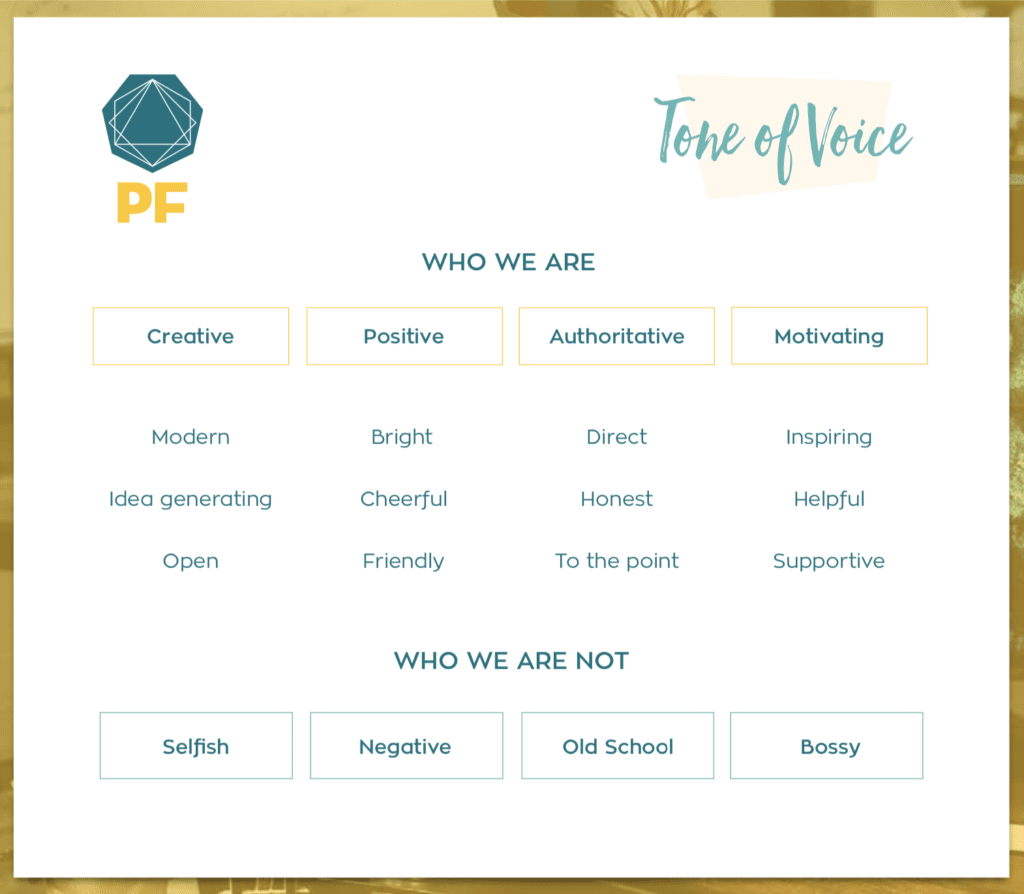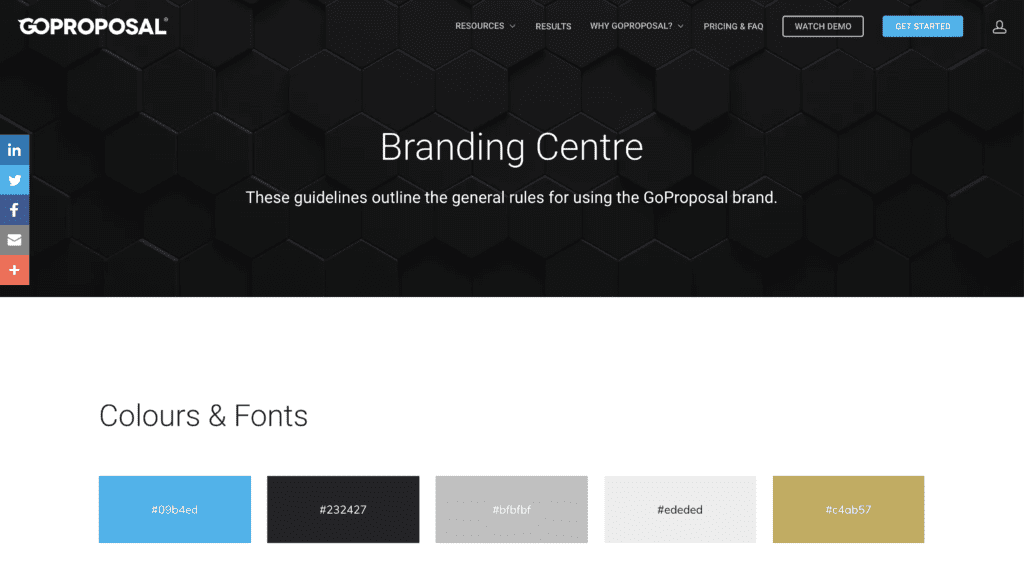
It’s SO important for your firm to have brand guidelines in place so all your marketing is consistent and gives the same impression to your target audience about who you are, your authority and expertise. It makes any content or design work easier and faster to create too – for you, your team, or your marketing agency.
If you’ve had a logo made by a designer, you may be familiar with logo guidelines. Normally, when you get a logo designed, you receive a logo guidelines document. This sets the rules on how your logo will be used on your website and in your marketing materials (digital and print). It will provide you with:
- Colours in hex code, RGB, CMYK and Pantone format
- Fonts which are potentially used as headings for body copy
- Exclusion zones (spacing around your logo)
- Restrictions (do’s and don’ts when using your logo)
Logo guidelines are necessary for designers to ensure your logo isn’t stretched, squeezed or the wrong colour, so that it is used consistently in your marketing.
Brand guidelines are more complex than logo guidelines
Although they may at first sound very similar, brand guidelines differ slightly from logo guidelines. While logo guidelines are simple (primarily for designers or those doing design work), brand guidelines are for everyone. For you, your team, those who work with you, even clients and prospects.
Everything to do with your brand, from your brand’s vision to your tone of voice and imagery, are covered in your brand guidelines document. Depending on how well you’ve identified your firm’s brand, this can be anything from a 7-page PDF to a larger, fully designed, even printed, 30-40 page brand book.
Brand guidelines cover these seven fundamental elements:
- Who you are (your values, what you stand for, your manifesto)
- Who you serve (your target audience, your ideal clients)
- Your tone of voice (words you use and don’t use, firm personality)
- The fonts you use (taken from the logo guidelines)
- The colours you use (hex codes, RGB codes, all that ‘design stuff’)
- The type of imagery and icons you use (with examples)
- Mockups and examples of designed marketing materials (letterheads, business cards, social image posts, website pages, etc.)
If you’re not clear yet on the detail behind some of these elements, such as a clear documentation of your values which you use every day, or a description of your style and tone of voice, you may need to do some more work on your brand. Don’t worry if you only have a few of these elements for now. Building a recognisable brand takes time.
If you want to get help defining exactly what your brand stands for; or if you have a logo and a name but you don’t have a ‘solid’ brand yet (or brand book), start with a one to one Foundations Workshop. Branding is one of the specific sessions, and it’s also integrated fully throughout the full workshop – where your brand comes from, how it’s represented on your website, and what actions relating to design and brand need to go into your plan.
To create brand guidelines, you need to know your brand
When we say brand, it’s not only about your logo and the colours you use, it’s the representation of everything you are – who you are, how you work, how you want to be perceived by the people you most want to reach.
Are you crystal clear on who you are, your values and who you serve? Are you able to communicate a consistent brand identity to your clients and prospects within your target audience?
Like every company, you want your brand to be recognisable and reliable. Having consistency throughout your marketing will help immensely. You will be viewed as a firm who lives by their values and takes pride in maintaining the quality of their service.
Your brand guidelines aren’t just for you
You’ll be working with several different people to create content for your brand. These content creators could be your team, external designers and copywriters, partners, sponsors and many more. These guidelines do not exist solely for you. It’s also made for people to refer to when working with your brand.
- Brand guidelines are for your team
Great if you know your brand’s identity by heart, but is every team member on the same page? Do you all use the same approach? What if new members join the team? Some firms we work with have a ‘brand book’ which was originally created for new team members.
It’s crucial for your team to have brand guidelines in place so there are no grey areas when it comes to understanding how your brand must be presented. When you make it easy for your team to learn and understand your brand, it will be easier for them to apply it to their work too.
When a team member writes a blog, records a video or shares social media posts about the firm, your brand guidelines help them make sure their content and actions match your brand. Even if each of the team members have their own personalities, they will be able to adhere to the same tone of voice and style whenever they create content for the firm.
You want to be seen as a tech-driven accountancy firm for example, but don’t want to use complex tech terms that may confuse your audience. This can be made clear in the brand guidelines to make sure your team shows that you are tech-driven but without going overboard. There are all sorts of specifics you can add in the guidelines about it. Use images with computers or tablets instead of piles of paper on your social posts. Avoid techy words that are far too complex but still use some if they’re needed. The team can always go back to these points and be reminded of what’s right and what’s not.
Farnell Clarke is a great example of a firm who has nailed their brand book. Their little book of information covers everything their team must know about the firm. From their history, to what they want to be known for, their values and even their suggested office attires, all these are mentioned in the book. It’s a great way to keep all the members informed and be on the same page. People can easily tell that someone works at Farnell Clarke because they’ll sense the same values from the team. Remember, consistency will make your brand appear more professional and reliable, this goes for keeping the team’s values cohesive with the firm’s.
At PF, we use our own tone-of-voice sheet (see below) as reference when writing our marketing tips. It reminds us of our brand’s characteristics, enabling the whole team to represent PF in the same style and tone of voice when we communicate with our audience. We also have a detailed “marketing tip guide notes” document which goes into far more detail about writing content for PF – including this marketing tip you’re reading right now!

- Brand guidelines are for strategic partners and sponsors
Your brand guidelines will also help your partners and sponsors know more about your firm, making it easier for them to work with you.
When you sponsor or exhibit at an event, you’ll be working with other businesses. In this instance, it lands on someone outside of your firm to represent you and your brand – and so you want to give them everything they might need to do that well.
The last thing you want, having invested time and money into your logo, is to have an old pixelated version shared publicly on an event banner. Or to have spent hundreds or thousands sending your team out to events in branded clothing, only to find that the wrong colour scheme has been used on all the supporting promotional materials. Think of your partners and sponsors as if they are your team – treat them as brand ambassadors.
If you take a look at our PF brand hub, you’ll see we even have a pre-written biography of Karen, for sponsors to use in their promotional material. We found every time we worked together with another company, they were asking for a bio and photographs and fonts and imagery. It’s all there. The beauty of this is your partners and sponsors can do the marketing for you, conveying your values and purpose with the same impact and enthusiasm you would.
Go Proposal also has a web page solely for their logo guidelines. They call it their branding centre and it contains everything a designer needs with regards to their logo. Event organisers also have access to some of James Ashford’s photos for when he will be speaking. Very handy as anyone with the link can access it.

- Brand guidelines for external designers, copywriters and subcontractors
The same goes for external designers, copywriters and subcontractors. Having a centralised document means fewer discussions about colours, fonts, logo layout, style, tone of voice. It makes marketing SO much easier, simpler and more efficient!
A brand guidelines document becomes the solid framework that’ll serve as a starting point for designers, copywriters and developers you’ll be working with.
I’ve been working with PF for more than 3 years now as the in-house graphic designer and I can say it’s far easier working with clients who have their brands nailed and branding guidelines ready. There’s no need for me to personally discuss colours, fonts nor imagery with the client anymore because I already have the basic information I need to start creating the designs.
Without a single clue about the firm’s personality, who their target audience are, what they’re like, our copywriters will not be able to communicate with the right people in the style they resonate with, too. The written content may turn out to be irrelevant and it’ll only confuse the readers.
That’s why it’s great to have some guidelines to start with rather than working from scratch and worrying about what our clients like and don’t like.
Brand guidelines also allow flexibility for us designers and copywriters. It helps us to be more creative with the brand we’re working with while still keeping the brand’s consistency. Our job is to explore ideas so an existing brand never gets stale, and while doing so, we also keep in mind any rules and restrictions so that we don’t go too far off brand.
Find out about everything you need to supply to your designers when giving them instruction.
- Brand guidelines for the printers
Business cards, newsletter, posters and even swag apparel can be tricky when designers and printers don’t have enough information about your brand. A lot of printers need the exact Pantone or CMYK colours to print custom made designs exactly as they were designed. It can turn out to be a disaster if the designer and printers are not on the same page. Colours for example may look different depending on the computer screen and a slight change in shade or tone can totally ruin your marketing material.
Of course, we don’t want to be wasting time and money for such mistakes, so sending your branding guideline to both the designers and printers will help everyone to be consistent throughout.
No need to worry about being wrongly represented
It will be nearly impossible to keep track of your brand’s consistency all throughout your marketing without guidelines to refer back to. So having a centralised document you can send to anyone who might need it will remove any worries about your brand being represented the wrong way.
When you run an event and your logo is printed on the marketing materials or on a pop up stand, you’ll be confident it has the same powerful impact and good impression it has on your website. When someone visits an exhibition stand at which you’re presenting, they get the same feeling from your social media channels and videos. When a team member writes a blog post or shares content on social, even though they have their own personality, it will overall give the same sort of impression your other content does. It all matches.
Setting rules and guidelines may feel restrictive, but branding guidelines are a support, a help. It means the content and design creators you work with will all adhere to the same things. They will all be working in a similar way: for you, and for your brand.
The foundations workshop will help you work through what your branding guidelines are: Pay a deposit for your foundations workshop today.

